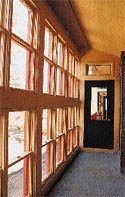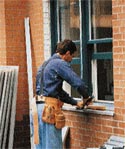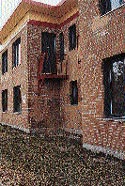
A new type of student dorm has sprouted out at McGill's Macdonald Campus, and it's not likely you'll find the boys from Animal House crushing beer cans on their foreheads and throwing toga parties at the Eco-Residence. The inhabitants of this unusual new dwelling are more likely to be budding botanists or agricultural engineers, and they've come together in ecological living groups in a residence designed to minimize the environmental impact of day-to-day life.
Ecological living groups? They first popped up in the 1970s on university campuses in California, with names like Synergy House, Agrarian Effort and Lothlorien, invoking visions of sandal-footed hippies living on nuts and berries. In reality, many are laboratory-like homes that incorporate environmental design and concepts such as passive solar architecture, recycling and composting facilities, biological waste water management systems and "green" lifestyles.The idea to apply the philosophy of ecological living groups at McGill was first suggested by Alexandra zum Felde, BSc(Agr)'99, after she discovered the concept while doing research on the Internet for an assignment. She approached Dean of Agricultural and Environmental Sciences Deborah Buszard about starting a group on campus.
 An interior view of one the new greenhouse balconies. The windows were recycled from the 1960s-era residence. Below: The old balcony at Robertson Terrace. Top: Before and after -- the old Robertson Terrace and the renovated EcoResidence. 
|
"Initially I was thinking of something much smaller, like one of the houses that were used for professors at Macdonald," says zum Felde.
Buszard was intrigued by zum Felde's idea, and, coincidentally, had just been fretting about what to do with the dilapidated Robertson Terrace student residence.
Buszard once described the facility as "rather like a cheap motel." Built by McGill in the 1960s for graduate students with small families, it was now in a sorry state. "Only six of the 36 units were habitable and there was extensive water damage to the building and roof," says the Dean. But with a $600,000 mortgage outstanding on the residence, demolition was not really an option. "Knocking it down would leave us with a continuing financial burden without any possibility of generating revenue.
"When Alexandra came to me, I thought, 'This is an interesting idea: students living together in a way that is less damaging to the environment.' Unfortunately, I didn't have a house available for them. Yet I had this enormous residence. And the light bulb went on." An energy efficient light bulb, naturally.
Buszard contacted Avi Friedman, MArch'83, from the McGill School of Architecture, known for his innovative housing projects, and he recommended she speak to Danny Pearl, BSc(Arch)'84, BArch'86, who with Mark Poddubiuk, BSc(Arch)'84, BArch'85, had started an architectural firm specializing in environmentally friendly design called L'OEUF (L'Office de l'eclectisme urbain et fonctionnel). Friedman, Buszard and L'OEUF began preparing a feasibility study which had to prove economic viability for the project, not just provide an environmental approach.
"Working with Danny," says Buszard, "we put together a proposal to go to the University's Budget Planning Group, and by August 1996, we had approval and were doing repairs to make sure the roof would survive the winter while we went ahead with the final planning for the design."
A good egg
L'OEUF began in the early nineties as a response to the planned demolition of a low-cost housing complex in west-end Montreal known as Benny Farm. Subsequent visits to Amsterdam and Toronto to learn about ecologically responsible architecture and construction led Pearl and Poddubiuk firmly down the environmental path.
"We realized it was a massive waste of money and time, not to mention the destruction of communities, to demolish buildings instead of trying to renovate and recycle," says Pearl from his office in Montreal. "But in order to prove the economic viability of such products you have to become experts in environmental and ecological reuse, have to prove it ecologically and economically."
 Professor Bob Bonnell hopes to add on a "living machine" to the EcoResidence in the near future.  These porthole windows let in light and provide a more friendly appearance to the exterior.
|
When Pearl and his team went to examine Robertson Terrace, "we were shocked that the buildings were all in concrete block: you can't afford to build like that anymore. The 'carcass' of the buildings was in good shape. But we got in there just before the buildings were severely damaged."
While the run-down buildings were salvageable, they were also rather hideous. "We proposed to recycle and rehabilitate the buildings," says Pearl, "but also to make them more attractive. They had a very negative image, and they didn't respond anymore to the type of student on campus."
The eco-makeover
The result is an ecologically friendly complex that's much easier on the eye, brightly painted in reds, oranges, yellows and greens, redesigned for better privacy, with greenhouse balconies on the upper floors, a new slanted roof, and spacious interiors filled with new furniture, wired for computers and the Internet, set up for recycling and composting, and renovated with environmentally safe materials. The residence has been divided into 20 "twoplexes" and 10 "sixplexes": two- and six-bedroom apartments that rent for $290-$360 per month. The energy efficiency has been greatly improved, and while budget limitations have not allowed for every ecologically friendly feature to go online just yet, the infrastructure is in place for features like the recycling of rain water and waste water filtration. "The idea was to do as much as we can now, put the infrastructure in, and the rest can be added without disruption later on," says Pearl.
Still, a lot has been completed already. Huge overhangs were added to the roofs, with new trusses added on to create an air space to prevent overheating in the summer, and the design encourages passive solar heating in the colder months. "In the wintertime," says Pearl, "the angle of the sun is about 15 degrees and it shines right into the upper floor. In the summer it's as high as 60 degrees, which means that most of the sun is blocked from the upper floor, keeping it cool."
The roofs are also designed to collect rain water which can then filter into a central area in both buildings to be stored in large tanks. "We allowed for cisterns to be installed and the rain water diversion to occur, but it's a future component that doesn't happen at the moment. Eventually it could supply all the water necessary for the students' laundry."
In addition to the energy efficient roof, "we blew recycled paper with borax into attic spaces to increase airtightness and energy efficiency tremendously. For all the windows we kept, we changed all the airtightness components. All the light fixtures that we installed are energy efficient."
The renovation and construction itself was carried out in an environmentally sensitive manner. Metal, wood, and other materials from the old residence were recycled into the new building. Construction and demolition waste makes up an astounding one-third of the solid waste going into Canadian landfills, and while federal initiatives have resulted in waste reduction, recycling in construction is still very rare.
  Old windows from the residence were planed and connected to use for the greenhouses, while new windows were added for energy efficiency.
 Old and new (paler) brick on the EcoResidence.
|
"We pushed as far as we could on recycling and reuse," says Pearl. This meant contractors used to dumping construction waste into one big pile had to adapt, separating out materials into piles of wood, masonry, metal and the like. "Most everything was reused, except for the masonry. We did do site separation so it went to a type of landfill where people looking to buy mass masonry could go and purchase it."
The materials used in the renovation were also green, free from the polyvinyl chlorides (PVCs) that are common in building materials -- in piping and tubing, plumbing fixtures, floors, windows and doors -- and that release large amounts of toxic chemicals and gas into the atmosphere.
"The goal was to set an example," says Pearl, "and to completely eliminate if possible the use of PVCs in the building. We succeeded everywhere on the project except for one item (the floor tiles)."
Room with a view
Among the more striking features of the new residence are the greenhouses along the front balconies. The windows for the greenhouses came from the old residence."We replaned and connected the old wood windows," Pearl explains, "and used recycled wood from the roof and doors."
The greenhouses themselves contribute to the overall energy efficiency. "The exterior walls of the buildings are made of four inches of brick," Pearl says, "and another eight inches of block behind that. When the sun hits that in the winter the energy is stored inside the wall and gives off heat hours later. But if it's exposed to the outside, the energy is lost. So by placing the greenhouses on those walls what happens is that the sun goes through the windows, heats up the brick, which radiates back the heat within the greenhouse because the windows keep it fairly airtight. Eventually the air gets radiated into the house."
The greenhouses will be used by students to grow plants for their research and course work. And while landscaping at the overall site hasn't been completed yet, individual gardens are planned for the front of each unit, as well as a large community garden in the central courtyard that would be used by both students and professors.
The living machine
The next big step for the EcoResidence is the plan for an ecological waste water treatment facility, a natural water purification process planned for the southern garden. Such facilities are sometimes called "living machines" and are ecological sewage treatment systems that use plants, animals and micro-organisms to purify waste water in much the same way as wetlands and marshes.
The facility would be housed in a large separate greenhouse and would not only result in purified water that could be released into the environment, but would be a valuable teaching and research tool.
"It would be an excellent facility for many courses to have part of their class take place here, everything from horticulture to microbiology, and faculty and students could use it as a lab," says Professor Robert Bonnell, BSc(AgrEng)'83, MSc'85, PhD'93, of the Macdonald Campus Agricultural and Biosystems Engineering department. But at an estimated cost of $400,000, McGill will need some help. "We're working on a deal with several groups who are interested in promoting their technology, and we'd benefit from getting the facility and the equipment to do research."
Student demand is high
While the architects, professors and administration are enthusiastic about the new complex, the students who live in the EcoResidence are equally excited. Sheryl-Ann Simpson, a first-year Animal Biology student, is currently living in one of the twoplexes and will be moving into a sixplex come September. "Building something like this on a university campus was a neat idea. A lot of people who lived here this year will be back, and we're trying to get everyone more active ecologically. There are two botany students living with me next year and they're very, very keen on the idea of using the greenhouses."
Still, because of budget difficulties, there have been some small snags along the way. "When we first got here we didn't have recycling," says Simpson, "which was ridiculous, considering where we're living. A bunch of people would collect newspaper, hop in someone's car and dump it at Laird Hall for recycling." Students have recycling now and worm composters are due for the coming term.
In the end, it's the students themselves who will determine the way daily life proceeds in the EcoResidence.
"We can't mandate how students will live," says Dean Buszard. "You don't have to do anything differently just because you're living there, but it's designed to encourage a certain awareness of nature and our need to cut down on our impact on the environment."
The dean sees a bright future for the residence and its inhabitants. "One of the things about the style of the building being centred around a courtyard is that it tends to bring everyone together. They've had pot luck suppers and meetings in each others' apartments, so it's already becoming a community."
And curiosity about the EcoResidence just keeps growing. Bob Bonnell has heard from many interested professors, including one who's looking to grow turf on the roof for energy conservation and additional filtration of the rain water. "Just think if you were driving along that expressway, looked out, and everybody's roof was covered in grass: it would sure look a lot nicer. You'd have cleaner air."
And an even greener residence.
|